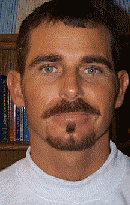 The Bard's Tale series of games were originally created by Michael Cranford,
pictured at left. He has an elegant programmer's touch. You can't
see it in this picture of him, but you can see it in The Bard's
Tale series. Before launching The Bard's Tale phenomenon,
he had previously programmed the Apple version of the classic Donkey Kong arcade game, the Commodore 64 version of Super Zaxxon -- not to mention a Commodore 64 game entitled Maze Master which plays like a "beta" version of The Bard's Tale. The Bard's Tale series of games were originally created by Michael Cranford,
pictured at left. He has an elegant programmer's touch. You can't
see it in this picture of him, but you can see it in The Bard's
Tale series. Before launching The Bard's Tale phenomenon,
he had previously programmed the Apple version of the classic Donkey Kong arcade game, the Commodore 64 version of Super Zaxxon -- not to mention a Commodore 64 game entitled Maze Master which plays like a "beta" version of The Bard's Tale.
The
Bard's Tale was the fourth game created by Interplay
Productions, and it was distributed by Electronic
Arts. The working title was Shadow Snare, and the original pitch document describes it as,
"...a role playing game set in a medieval fantasy world. If it could be called similar to any existing game, that game would be Wizardry, by Sir Tech Software. The object in the design of Shadow Snare has not been to copy Wizardry, but to come up with a role playing game of similar, though greatly increased, playability. The graphics, sound, and content would be ten times that of Wizardry, which is still a top seller, along with its varied scenarios and Ultima III. Unlike Wizardry, the town in Shadow Snare is depicted with a series of small (though highly detailed) graphic pictures, some of which are animated. The display is graphic, and the text output window scrolls messages up smoothly. All disk access will be quick and hardly noticeable, even on the Commodore 64 (which Wizardry is not even released on)."
As "Burger" Becky Heineman explains,
"Brian
Fargo was the main guy, he and Jay Patel, Troy Worrell and myself
were the first 4 people who were Interplay... In 1984, Mike Cranford
suggested that Interplay Productions should do a fantasy role
playing game (Wizardry was hot at the time). However the
game's name was 'Tales of the Unknown'... Mike never 'worked'
for Interplay. He was an independent contractor. he was able to
do this since he was an old high school buddy of Brian Fargo.
Cranford worked in an office at Interplay up until the completion
of Bard's Tale I. He did Bard's Tale II from his
home."
Many fans of
the Bard's Tale series don't realize that its creator has
a very strong Christian faith which is evident in the games—for
example, there are direct references to Jesus and his crucifixion
in The Bard's Tale, and all but one of the city names from the second
game are taken directly out of the New Testament of the Bible. (In
fact, the power of the Destiny Knight in The Bard's Tale II is
stated to be that of the Holy Spirit.) When I asked
Michael why he was not directly involved in The Bard's Tale III, he said that,
"The reason
I wasn't involved in BTIII is complicated. Part of it was that
I wanted to leave Interplay so that I could go back to school.
I was pretty burnt out on D&D game programming . . . and wanted
to pursue studies in philosophy and theology. I also thought I
didn't need Interplay at that point, and had a falling out with
Brian Fargo. It turned out to be a good decision spiritually,
though not financially!" (E-mail, 1998)
And he wasn't
kidding—after leaving Interplay, Michael earned a bachelors
degree in philosophy from the University of California, a Master
of Divinity from Talbot School of Theology, and a Ph.D. in Religion
and Social Ethics from the University of Southern California with
a disertation focus on ethics and technology. He has taught both
graduate and undergraduate courses in ethics and theology, and has
publications in several New Testament journals and in scholarly
journals of ethics and contemporary postmodern culture.
Michael is
also founder and senior designer of the Irvine, California web site
design company, Ninth
Degree.
Not surprisingly, his very first Internet web design project was
a web site for Christian outreach called Sundoulos,
"the web's premier forum for discussions on theology, ethics,
and culture." (Now named OneSteadfast.)
I found a humourous
audio recording from a lecture Michael Cranford
gave on fasting where he talks briefly about how
"Burger" Becky Heineman got her nickname. Becky (then named Bill) is the programmer of Thief of Fate. |